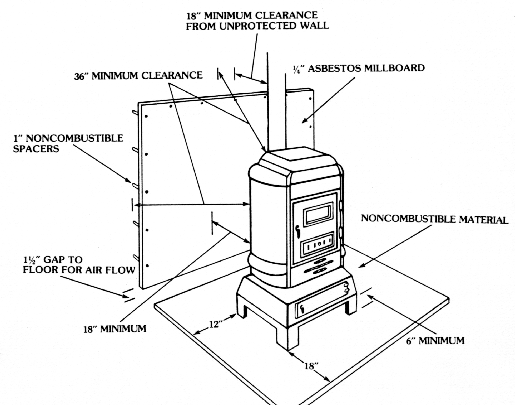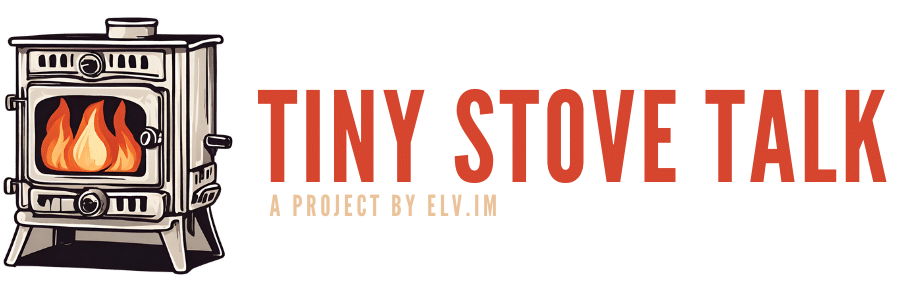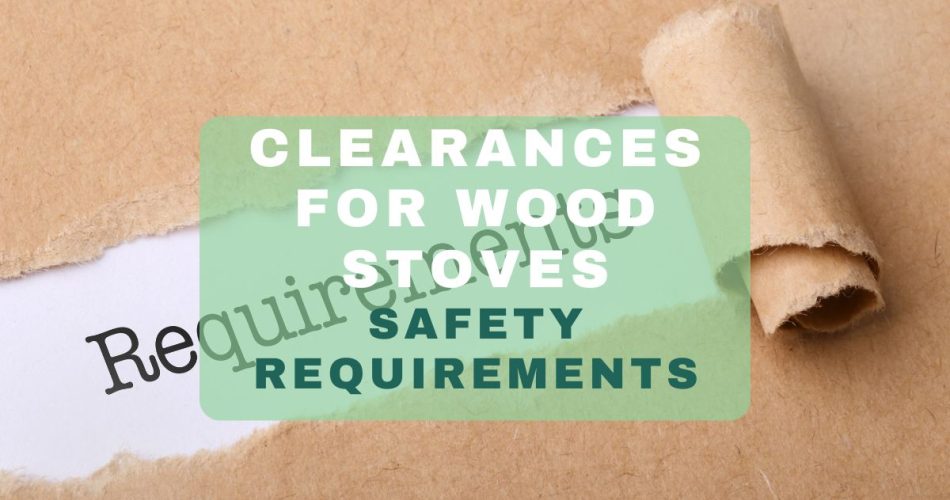My venture into the world of wood stoves and fireplaces began with a simple appreciation for their warmth. But as I learned more about them, I quickly realized how much of a safety nightmare they can be if you don’t know what you’re doing. This is especially true for clearance for wood stove.
And when one friend’s negligence nearly caused a disaster, I knew it was time to take wood stove clearance seriously. The incident involved an installation that didn’t provide adequate spacing. If it hadn’t been caught in time, it could’ve destroyed property or worse… hurt people.
That experience forced me to dig deep into the importance of clearance. It is a critical but often overlooked regulation that keeps your fireplace (and home) safe.
Today, I will share my experience setting the clearance for my wood stove. So, stick around, and let’s ensure your cozy space stays cozy—and doesn’t accidentally turn into an inferno.
Understand the Requirements
Clearance is all about giving your wood stove enough space. You must ensure a safe distance between your heat source and combustible materials for safety reasons.
Imagine putting a red-hot heating system next to a stack of firewood. It’s not safe, and it can start a fire! That’s why wood stoves and fireplaces need enough space for walls, furniture, flooring, or anything easy to burn. It also helps with heat transfer.
I learned that you must consider certain factors for the clearance of your wood stove. These factors include the following:
- Type of Appliance: Each appliance has a unique design and heat output. This means that their clearances will vary as well.
- Heat Output: Some appliances lose more heat up the chimney than others, and some radiate heat over long periods.
- Installation Type: Each installation has a venting system that can affect the heat output.
- Guidelines for Clearances: The distances experts recommend can significantly differ based on the abovementioned characteristics and details.
- Manufacturer’s guidelines: Professionals follow these guidelines to keep things warm without starting a fire.
You’d be surprised at how much thought goes into preventing fires caused by wood stoves or fireplaces. People who work in this industry aren’t just doing things randomly; everything is calculated carefully to ensure safety while keeping things comfortable indoors.
National and Local Codes
As I learned more about clearance for wood stove, I realized it wasn’t as simple as just installing it wherever you want. There are national and local codes dedicated to regulating this kind of thing—codes that don’t just exist to annoy people like me who want a warmer home, but codes explicitly designed to keep us safe while staying cozy at home!
Just as the name suggests, national and local codes are regulations that govern how wood stoves and fireplaces should be installed. These codes ensure comfort and safety in our homes.
Here are some important things I picked up regarding these codes:
National Standards for Stove Clearances
The National Fire Protection Association or NFPA provides guidelines for installing these appliances. They focus on venting, chimney height, combustible clearance, etc. While they’re already very comprehensive, appliance manufacturers offer more specific instructions to make sure installations meet or exceed safety standards.
Local Building Codes
Different areas have different needs regarding comfort and safety. That’s why some places put additional requirements for fireplace clearance on top of national standards. These additional requirements ensure everything goes according to plan. For example, my community has stricter regulations about historic homes. These homes are more prone to accidents than modern ones.
The Importance of Compliance
One thing I learned quickly is how to stay in compliance with both national and local codes. It’s not just about avoiding fines or other legal issues. It’s about keeping a safe environment inside the home. Some installations can put your house at risk of fire or carbon monoxide poisoning if they’re done incorrectly. Hence, adhere to these codes for your clearance.
Checking and Double-Checking
Before installing everything, I spoke with my community’s building and fire safety officials. Not only did these conversations help me make sure my work was up to the code, but they also gave me peace of mind, knowing my family would be safe.
Considerations for Clearance for Wood Stove

Diving headfirst into fireplace installations, I realized that clearance is a significant ordeal depending on what kind of fireplace you’re dealing with. Knowing these differences was crucial in making sure everything ran smoothly and safely. Here’s what you need to know:
Traditional Fireplaces
Those classic brick fireplaces that everyone loves always look amazing, but they have specific requirements to ensure everything goes perfectly. Some of those include:
- Clearance from materials that can combust: Be sure that the distance between your fireplace and whatever might ignite due to heat transfer is correct.
- Minimum wall clearance needed: Typically, these fireplaces require at least 12 inches from the nearest flammable object, but this could change for other reasons like insulation or wall material.
- Mantel and surround clearance: Space out your fireplace opening from mantels and surrounds so that nothing has a chance to light up around them.
- Hearth clearance: If you can, use something that won’t catch on fire for your hearth so it’s less likely for it to become damaged or ignite anything else surrounding it.
Prefab Fireplaces
On the other hand, more convenient options for homeowners are prefabricated or “factory-built” fireplaces. They’re easier to install but still have important rules such as:
- Manufacturer guidelines: Simply put, follow any rules provided by the manufacturer because there may be specific clearances based on design and construction.
- Distance from combustible materials: Another blanket rule is to ensure nothing near the fireplace will go up in flames. This includes walls, mantels, furniture, and flooring. The distance needed usually depends on how the fireplace is designed and built physically.
- Minimum wall clearance needed: Different insulations or wall materials require different distances between your walls.
- Mantel and surround clearance: Like traditional masonry fireplaces, space out your mantels and surrounds so nothing catches on fire.
- Hearth clearance: Follow the manufacturer’s instructions for clearances between the fireplace hearth and flooring. Non-combustible materials or elevated hearths might be recommended to reduce the risk of ignition.
Breezing through the clearance requirements for fireplaces was a learning experience. It reminded me how significant it is to pay attention to detail. Noting specifics with masonry and prefabricated fireplaces will ensure you’re in a cozy setting without risking any danger.
Clearance Basics for Wood Stoves
I quickly learned that moving to wood stoves from fireplaces shared the same clearance principles but varied in specifics. Understanding the basic guidelines for clearance for wood stove is vital to its safe and efficient operation within your home. Here’s what I found:
Main Clearances
Wood stoves need enough space between walls, ceilings, and flooring to avoid potential fire hazards. These measurements can change depending on the case, but here are some general considerations to keep in mind:
Walls
- Without protection: Typically, you want your wood stove to be about 36 inches away from unprotected walls.
- With protection: With heat shields installed on the wall, this distance can be reduced by a lot, sometimes as little as 12 inches, with suitable material and design.
Ceilings
Unless specified otherwise by your stove manufacturer, at least 18 inches should be between the top of your stove pipe and ceiling. However, there usually needs to be a much bigger gap between the ceiling and the stove itself. Sometimes, it can even be several feet if there isn’t a fan to disperse the heat buildup.
Flooring
A non-combustible floor protector must be under all wood stoves (use materials like metal or ceramic tile). It should extend at least 18 inches in every direction from the stove. However, this area may need to be larger depending on size and heat output.
Important Details
- Refer to your specific wood stove model’s installation instructions because they could vary significantly from others.
- Local codes may have stricter clearance requirements for wood stoves than those included with your purchase. So, you must check these with local authorities or someone who installs them professionally.
- A professional installer will ensure all safety standards and regulations are followed during installation.
Heat Shields
Heat shields make wood stove installations safer by reducing clearance distances between combustible materials and the stove. They reflect, absorb, and dissipate the heat the stove emits to avoid direct contact with heat on surfaces.
If you use heat shields to reduce requirements, please ensure they are installed exactly as the manufacturer instructs. Measure and mark your areas with the reduced distances as safety standards suggest.
Measuring and Marking Clearance for Wood Stove
Marking the clearance zones around a wood stove can be a lifesaver. It ensures that:
- You’re being fire-safe.
- You’re following local and manufacturer’s guidelines.
- You’re not making your living situation worse than it already is.
In this step-by-step guide I followed yesterday to measure and mark these zones accurately:
1. Do some research.
Check the manual with your wood stove to find out where they recommend you put their product about walls, ceilings, and flooring.
It would be best to research what codes and regulations are in place around installing stoves like yours in your area.
2. Find out what needs to be measured.
If you use it for warmth, there will probably be surfaces near your stove – walls, ceiling, and flooring. So, get ready to mark them down. Don’t forget about the stovepipe if that applies to you, either.
3. Get your measuring tools ready.
You will need appropriate tools to measure the clearance of your wood stove. Here are some that you may need:
- A tape measures
- Pencil or chalk line
- Notepad for writing stuff down
- Level (optional – it’s so that things look straight)
4. Measure from the walls.
- From each side of the stove: Use the tape measure to take measurements from the side of the stove recommended by its maker as safe distances away from combustible things like walls. Pencil those points onto the floor once you’ve found them.
- Vertical clearance: If necessary, measure how far away from combustible materials (like said wall) your stove sits when facing up at the ceiling. For reference’s sake, this will help you mark vertical lines on walls later.
5. Measure from the ceiling.
Use the measurement above to determine how far below any material suspended above must sit from its peak before it becomes a fire hazard.
6. Measure from the flooring.
Measure how far away from the wood stove your non-combustible materials must sit. For my clearance for wood stove, I measured 18 inches.
7. Mark it down.
Connect the dots (or lines) you’ve marked on the floor to create a perimeter around your stove, showing you how close combustibles can get before they ignite.
Do something similar along walls for both vertical ceiling and horizontal sidewall measurements. This way, whenever you’re near this wall or looking at it, you’ll be reminded, “Hey, don’t store anything close to me!”
8. Double-check the measurements.
Go through each measurement and line to ensure they comply with the required clearance for wood stove. You don’t want to go an inch below clearance if your living room is made entirely from timber.
9. Add another layer of protection.
Sometimes, fire safety can’t be avoided by just being aware. Your home might not burn down due to its lack of compliance at this moment… but eventually, it will without these precautions:
- Heat shields
- Non-combustible wall materials
- Floor pads
10. Conduct maintenance checks.
So long as you’re using your wood stove, double-check that everything is functioning correctly now and then and hasn’t rusted away or become useless.
Tips for Ensuring Accurate and Compliant Clearance for Wood Stove

I’ve been reflecting on the right clearance and have come up with some takeaways that might help others.
Understanding Manufacturer Guidelines and Local Codes
- Thorough preparation: I first read the installation manual cover to cover when I got my stove. Then, I dove into local codes. It made everything so much more apparent from that point forward because it wasn’t just following instructions but understanding why each instruction existed in the first place.
- Asking for expertise: A lot of times while reading through guidelines, I would scratch my head and wonder if they were written in Klingon. So, I contacted certified professionals and the fire department to answer some questions. Not only did this ensure my installation was compliant, but they also offered some practical tips that manuals couldn’t communicate.
Precise Measurement and Marking
- Get good measuring tools: Early on, you’ll realize the importance of precise measurements. Do yourself a favor and invest in a tape measure and level that won’t let you down. You need accuracy, sure, but you also need confidence.
- Double measure everything: As soon as I took one measurement, I knew immediately what had to be done next: take another one. And sometimes even a third. If you’re not careful, the slightest mistake could quickly turn into something big, so taking extra time on this step wasn’t optional.
Heat Shields and Protective Materials
- Be picky about shields: There are countless options for heat shields these days, but make sure you find ones specifically designed for wood stoves. That’s what you’re looking for here; compatibility isn’t enough, safety is also vital.
- Learn about air gaps: This part taught me much about physics. Understanding air circulation’s impact on heat transfer helped me appreciate why the shields need proper air gaps. It’s not just about following the instructions. It’s about understanding how my home stays safe from the fire I’m burning.
Installation and Maintenance
- Trust experts: No matter how much you study and prepare, getting an expert on board is always a good idea. In my case, hiring a professional installer was a turning point. Not only did they ensure everything was safe, but having their name attached to the work gave me peace of mind that DIY couldn’t offer.
- Be proactive with maintenance: I’ve gotten into the routine of regularly checking and maintaining things. Check for signs of wear and tear in your stove, ensure your chimney stays clean, and replace parts before they fail. Doing these things has kept my stove efficient enough to run smoothly while keeping us all safe.
The most important thing I learned through this process was respect. Respect for fire’s power, respect for the wisdom written in guidelines and codes, and respect for professionals’ expertise.
Common Clearance Mistakes for Wood Stoves
Here are some of the mistakes I’ve encountered or heard of:
Ignoring the manufacturer’s clearance instructions
Some installations don’t follow the proper clearance distances from combustible materials specified by the manufacturer. This can cause nearby material to overheat, which could ignite in the worst-case scenario, causing a fire.
Using heat shields improperly
Many people who install heat shields don’t understand their specific requirements. For example, these shields need air gaps and shield material. Ignoring these requirements can result in insufficient protection from heat.
Neglecting vertical clearance for wood stove
Vertical clearances for chimneys and stovepipes are sometimes overlooked. Overlooking the clearance increases the risk of attic or roof space fires due to overheating ceilings and roof materials.
Ignoring floor protection
In some cases, non-combustible floor protection was either too small or completely absent. This poses serious risks, such as floor damage, fire from embers, or falling logs.
Tips To Avoid These Common Clearance Mistakes
Here are some tips on how you can avoid the clearance mistakes mentioned above:
Strictly adhere to guidelines.
Always follow the manufacturer’s installation instructions and local building codes in the letter. These guidelines exist primarily for your safety.
Consult and hire professionals.
If you aren’t confident you can meet safety requirements for clearance for wood stove, hire a professional. Their experience will prevent many common mistakes from happening.
Do regular inspections and maintenance.
Regular inspection of your fireplace or wood stove, especially before the heating season begins, is crucial. Maintenance checks can catch and mitigate risks before they become problems.
Educate yourself on heat shield use.
Figuring out how to use a heat shield isn’t enough. You need to know “why” it works and the principles behind its protective measures to guide you toward safer installation practices.
Prioritize safety over aesthetics.
I know plenty of people who place their stove or fireplace too close to walls or furniture for aesthetic reasons. Safety should always be prioritized over these things. Adjust room layouts or choose stove models that fit your space safely.
From my experience, diligence, education, and respect for fire are crucial to having a safe and warm home. Mistakes can have severe consequences, but most pitfalls can easily be avoided with careful planning and strict safety guidelines.
Conclusion
Reflecting on my journey with clearance for wood stove, I cannot stress enough the importance of adhering strictly to safety requirements. These requirements are not arbitrary. If you aren’t strict with this, one mistake could cost you much more than just another installation.
Fireplace and wood stove installations must be safe. Anything less is a recipe for disaster. Sometimes, just one small mistake can result in huge problems. That’s why it’s crucial to take every possible precaution.
So, you must prioritize safety when setting up or maintaining your fireplace or wood stove. Look up the manufacturer’s guidelines and stick to them, whether you like them. Follow all local building codes religiously, too, as much of a hassle as that may be. And don’t hesitate to bring in professionals if you need some help.
If you build a fire in your house, ensure it’s warm and secure!
Additional Resources
Here are some helpful guidelines you can read to know more about fireplace and wood stove safety:



Comments